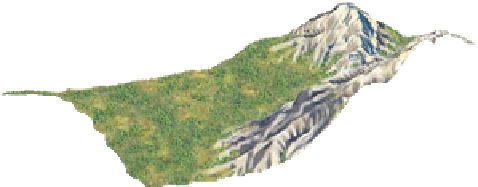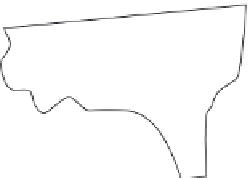Geoscience Reference
In-Depth Information
Earth right now that is spreading lava across the surface, or did a
large flood recently happen that deposited mud in river valleys?
If such an event is taking place, then the foundation is being set
for the development of solid rock at those locations in the future.
Because of the many different chemical elements that oc-
cur on Earth, an extremely wide variety of rock types exist. It
goes far beyond the scope of this topic to describe each one of
the many different kinds of rocks. Instead, we will focus on the
three major rock classes—igneous, sedimentary, and metamor-
phic—and some fundamental kinds of rock that occur within
these groups. After completing this section of the chapter, you
should be able to identify these basic rocks, determining wheth-
er they lie randomly on the ground or are exposed at the surface
in a
rock outcrop
. The presence of a particular rock type yields
important clues about the geologic history of the area.
flows across the surface of Earth as red-hot
lava
(Figure 12.6b)
that erupts from volcanoes. This liquid rock ultimately cools to
form
extrusive igneous rock
, which is so named because it re-
sults from magma that flows out of—or extrudes from—Earth.
In contrast to the magma that flows onto the Earth's
surface and cools, the majority of magma cools within Earth
(Figure 12.6a) to form
intrusive igneous rock
, so named be-
cause the magma intrudes into older rocks. This cooling process
can occur in a variety of places beneath the Earth's surface, with
any body of intrusive igneous rock referred to as a
pluton
. The
largest plutons are called
batholiths
, which are features of no
known depth that are up to several hundred kilometers long and
100 km (62 mi) wide. A smaller, somewhat rounded pluton that
is attached to a batholith is called a
stock
.
In some instances, magma will move upward from a magma
chamber into relatively small fissures within the overlying rock.
One such feature is a
dike
, which is a pluton that consists of a wall-
like feature that develops when magma intrudes into a vertical rock
fracture. Sometimes magma moves upward through such a frac-
ture and then spreads horizontally within the crust along zones of
rock weakness, forming a pluton called a
sill
. In other cases, up-
wardly moving magma spreads horizontally along a zone of rock
weakness, while at the same time pushing upward in such a way
Igneous Rocks
One of the distinctive categories of rocks on Earth is that associ-
ated with liquid rock, known as
magma
, that originates in the
mantle and moves upward into the Earth's crust or onto the sur-
face (Figure 12.6a). When this magma cools, it solidifies to form
igneous rocks
. You are probably most familiar with magma that
Volcano
Vent
Active
lava flow
Laccolith
Ma
in
pip
e
(b)
Stock
Sill
Dikes
Active magma
chamber
Figure 12.6 Various kinds of igneous environ-
ments.
(a) This diagram illustrates the different ways
that intrusive and extrusive igneous rocks form. (b) Lava
flow at Mauna Loa Volcano in Hawaii. This material will
ultimately cool and darken, consistent with the dark
material surrounding it, forming extrusive igneous rock.
Batholith
(a)
A place where rocks are exposed at the surface
Rocks that form when magma cools
Rock outcrop
Extrusive igneous rocks
of Earth.
on the Earth's surface.
Molten rock beneath the surface of Earth.
Rocks that form when magma cools
Magma
Intrusive igneous rocks
within the Earth's crust.
Igneous rocks
Rocks that form when magma rises from the
mantle and cools, either within the Earth's crust or on the surface.
Pluton
An extremely large mass of intrusive igneous rock that
forms within the Earth's crust.






























































































































































































